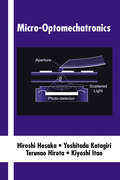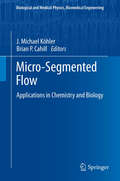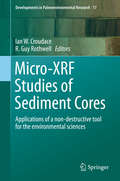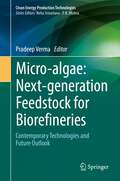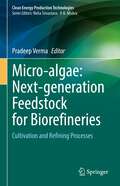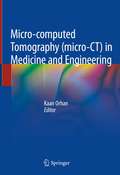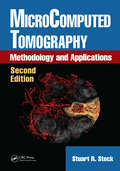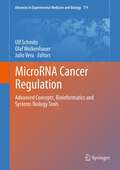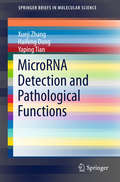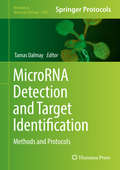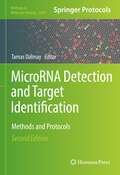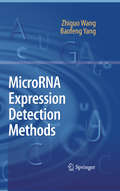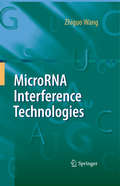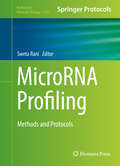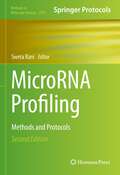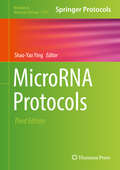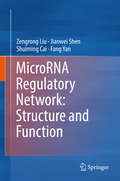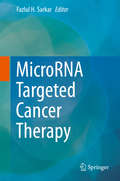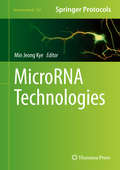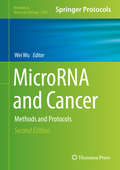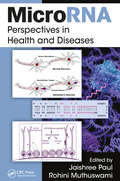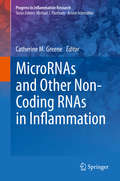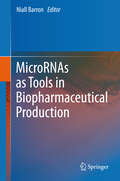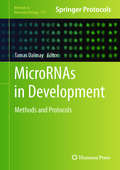- Table View
- List View
Micro-Optomechatronics (Optical Science And Engineering Ser. #92)
by Hiroshi Hosaka Yoshitada Katagiri Terunao Hirota Kiyoshi ItaoFusing developments in optics, electronics, and mechanics, this reference systematically explores and describes an abundance of micro-optomechatronic devices and applications. The authors outline the power and position control of a laser beam, as well as fundamental principles in optical technology.Contains examples of micro-optomechatronic
Micro-Pollutant Regulation in the River Rhine: Cooperation in a Common-Pool Resource Problem Setting
by Laura Mae HerzogThis book investigates how actors organize in order to solve a water quality problem. Research on the use of environmental resources has mainly focused on the circumstances needed for users to self-organize or to maintain an already sustainable way of resource use. Few studies have investigated the reasons why actors start to cooperate when they are faced with an environmental problem. Actor networks in three regions of the Rhine catchment area are scrutinized regarding a) actors’ cooperation pattern when managing an environmental problem; and b) the factors that trigger actors in a common-pool resource situation to initiate cooperation. Water quality policy is analysed in two European countries – Germany and Luxembourg – and one non-European country - Switzerland –, providing an overview of the distinctive measures applied in these regions aiming to tackle the water quality problem of micro-pollutants in river surface water. Applying the social-ecological system framework (SESF) devised by E. Ostrom and her colleagues and Social Network Analysis (SNA), the current book combines qualitative and quantitative methods to answer the question of why actors cooperate in the management process of an environmental problem like water pollution.
Micro-Segmented Flow
by J. Michael Köhler Brian P. CahillThe book is dedicated to the method and application potential of micro segmented flow. The recent state of development of this powerful technique is presented in 12 chapters by leading researchers from different countries. In the first section, the principles of generation and manipulation of micro-fluidic segments are explained. In the second section, the micro continuous-flow synthesis of different types of nanomaterials is shown as a typical example for the use of advantages of the technique in chemistry. In the third part, the particular importance of the technique in biotechnical applications is presented demonstrating the progress for miniaturized cell-free processes, for molecular biology and DNA-based diagnostics and sequencing as well as for the development of antibiotics and the evaluation of toxic effects in medicine and environment.
Micro-XRF Studies of Sediment Cores
by Ian W. Croudace R. Guy RothwellThis volume presents papers on the use of micro-XRF core scanners in palaeoenvironmental research. It contains a broad ranging view of instrument capability and points to future developments that will help contribute to higher precision elemental data and faster core analysis. Readers will find a diverse range of research by leading experts that have used micro-XRF core scanners in a wide range of scientific applications. The book includes specific application papers reporting on the use of XRF core scanners in a variety of marine, lacustrine, and pollution studies. In addition, coverage also examines practical aspects of core scanner usage, data optimisation and data calibration and interpretation. In a little over a decade, micro-XRF sediment core scanners have made a substantive contribution to palaeoenvironmental research. Their impact is based on their ability to rapidly, non-destructively and automatically scan sediment cores. Not only do they rapidly provide important proxy data without damaging samples, but they can obtain environmental data at decadal, annual and even sub-annual scales. This volume will help both experienced and new users of these non-destructive core scanners take full advantage of one of the most powerful geochemical screening tools in the environmental scientist's toolbox.
Micro-algae: Contemporary Technologies and Future Outlook (Clean Energy Production Technologies)
by Pradeep VermaThe edited book covers all potential products from microalgal-based biorefinery having the focus on contemporary technologies and future outlook. Along with the focus on microalgal biorefinery products, the book also focuses on biotechnological advances via the utilization of modern molecular biology, system biology, synthetic biology, or metabolic engineering approach in microalgal biorefinery. The development of any technologies has a direct effect on the human being and the environment, therefore, the socio-economic, techno-economic, and environmental impact of the microalgae-based biorefineries will also be included in the book. In microalgal biomass-based biorefinery different biofuel- biodiesel, bioethanol, bio-hydrogen, and value-added compounds such as carotenoids, fatty acids, and protein can be produced simultaneously. Understanding the technical advances to develop an integrated biorefinery approach with the motive of designing a consolidated self-sustainable microalga-based biorefinery. This book is equally beneficial for researchers and engineers in biomass-based biorefineries or the bachelors, master, or young budding graduate students as a textbook.
Micro-algae: Cultivation and Refining Processes (Clean Energy Production Technologies)
by Pradeep VermaThis edited book provides an account of past, present, and future constraints in microalgae-based biorefineries, emphasizing cultivation and refining processes. The book offers an insight into the recent advancements in the technologies and methods developed microalgae-based biorefinery for bioenergy and biochemicals production. The fast depletion of fossil fuels has forced researchers to move out of reliance on fossil fuels for the industrial and energy sector’s needs. Due to its rich protein and lipid content, microalgal biomass has been considered one of the suitable substrates for the biorefinery. Microalgal production and harvesting for biofuel and chemicals is a tedious task. Several technological advances have been observed in this area, thus systematically checking the viability of technology at laboratory scale and then moving to large scale production, harvesting, extraction, processing, and characterization is the main focus of the book. This book is equally beneficial for researchers and engineers in biomass-based biorefineries or the bachelors, master, or young budding graduate students as a textbook.
Micro-computed Tomography (micro-CT) in Medicine and Engineering
by Kaan OrhanThis book focuses on applications of micro CT, CBCT and CT in medicine and engineering, comprehensively explaining the basic principles of these techniques in detail, and describing their increasing use in the imaging field.It particularly highlights the scanning procedure, which represents the most crucial step in micro CT, and discusses in detail the reconstruction process and the artifacts related to the scanning processes, as well as the imaging software used in analysis. Written by international experts, the book illustrates the application of micro CT in different areas, such as dentistry, medicine, tissue engineering, aerospace engineering, geology, material engineering, civil engineering and additive manufacturing. Covering different areas of application, the book is of interest not only to specialists in the respective fields, but also to broader audience of professionals working in the fields of imaging and analysis, as well as to students of the different disciplines.
MicroComputed Tomography: Methodology and Applications, Second Edition
by Stuart R. StockMicroComputed Tomography has become the gold standard for studying 3D microscopic structures nondestructively, and this book provides up-to-date coverage of the modality. The first part of the book focuses on methodology, covering experimental methods, data analysis, and visualization approaches. Emphasis is on fundamentals so that those new to the field can design their own effective microCT studies. The second part addresses various microCT applications, organized by type of microstructure so that the reader can appreciate approaches from other disciplines. The applications include porous solids, microstructural evolution, soft tissue studies, applications using x-ray phase contrast or x-ray scattering contrast, and multimode studies.
MicroRNA Cancer Regulation
by Ulf Schmitz Olaf Wolkenhauer Julio VeraThis edited reflects the current state of knowledge about the role of microRNAs in the formation and progression of solid tumours. The main focus lies on computational methods and applications, together with cutting edge experimental techniques that are used to approach all aspects of microRNA regulation in cancer. We are sure that the emergence of high-throughput quantitative techniques will make this integrative approach absolutely necessary in the near future. This book will be a resource for researchers starting out with cancer microRNA research, but is also intended for the experienced researcher who wants to incorporate concepts and tools from systems biology and bioinformatics into his work. Bioinformaticians and modellers are provided with a general perspective on microRNA biology in cancer, and the state-of-the-art in computational microRNA biology.
MicroRNA Detection and Pathological Functions
by Xueji Zhang Haifeng Dong Yaping TianThis book summarizes microRNA (miRNA) biology in a variety of pathological processes, emphasizing the significant potential applications of miRNA in diagnostics and prognostics, as well as novel drug targets. The conventional techniques used for miRNA detection including standard PCR, Northern blotting, microarray and clone methods are addressed. Recent emerging strategies in miRNA detection and quantification with superior flexibility and adaptability, such as novel molecular biological techniques and locked nucleic acid (LNA) modified probes, as well as nanotechnology-based approaches, are also included. The book also highlights the latest advances in clinical-related miRNA detection methods in living cells, circulating blood and tissue, such as in situ hybridization (ISH) and molecular imaging techniques, which are useful to elucidate the biogenesis and biological function of miRNAs in vivo. Finally, the respective advantages and drawbacks of various detection techniques in this fast-moving field are discussed, along with the challenges and promising new directions. This book offers a valuable resource for analytical chemists, biologists and physicians involved in miRNA research. Dr. Xueji Zhang and Dr. Haifeng Dong are Professors at the School of Chemistry & Biological Engineering, University of Science & Technology Beijing (USTB), China. Dr. Yaping Tian is a Professor at the Department of Clinical Biochemistry, Chinese PLA General Hospital and Military Medical School, China.
MicroRNA Detection and Target Identification
by Tamas DalmayThis volume is a collection of miRNA detection and target identification protocols, detailing new developments in the traditional detection approaches such as northern blot, quantitative real-time PCR, array, next generation sequencing, and in situ hybridization. The chapters in MicroRNA Detection and Target Identification: Methods and Protocols guide readers through novel approaches such as nanotechnology, microfluidics, based detection methods, analysis of serum and urinary, miRNAs as biomarkers, target identification and experimental approaches. Written in the highly successful Methods in Molecular Biology series format, chapters include introductions to their respective topics, lists of the necessary materials and reagents, step-by-step, readily reproducible laboratory protocols, and tips on troubleshooting and avoiding known pitfalls. Authoritative and practical, MicroRNA Detection and Target Identification: Methods and Protocols aims to ensure successful results in the further study of this vital field.
MicroRNA Detection and Target Identification: Methods And Protocols (Methods In Molecular Biology Series #2630)
by Tamas Dalmay<p>This updated volume reflects new and evolved techniques to study detection, profiling, and manipulation of microRNAs (miRNAs) in plants and animals. After overviews of how best to detect, identify, and validate microRNAs, the book continues by exploring state-of-the-art prools for microRNA detection, approaches to profile the expression level of microRNAs, spatial expression analysis, describe in silico analysis of microRNAs and their targets, as well as prools for functional analysis of microRNAs and their targets by CRISPR/Cas. Written for the highly successful Methods in Molecular Biology series, chapters include introductions to their respective topics, lists of the necessary materials and reagents, step-by-step and readily reproducible laboratory prools, and tips on troubleshooting and avoiding known pitfalls.<p> <p>Authoritative and up-to-date, MicroRNA Detection and Target Identification: Methods and Prools, Second Edition aims to ensure successful results in the further study of this vital field.<p>
MicroRNA Expression Detection Methods
by Zhiguo Wang Baofeng YangThis book provides comprehensive descriptions of the innovative strategies and methodologies for detecting miRNA expression, their application in miRNA research and their potential as tools for clinical diagnosis and prognosis. It begins with the introduction of the overall concept and strategies of miRNA expression detection methods emphasizing the need of a wide variety of these methods to suit specific requirements for research and clinical examination in laboratories. In the following, each single chapter focuses on an independent, unique method of miRNA detection and is divided into five subsections: summary, introduction, protocol (including materials, instrument, reagent, and procedure), application and limitation, and reference. The development of the technique, the ideas behind it and the mechanisms underlying the method are given in the introduction of each chapter. The step-by-step protocols are detailed in the protocol section. Then, the applications and limitations of the methods are discussed. Finally, the literature citations are listed in reference section. Schematic diagrams are included where needed and appropriate for better illustrating the principle of the methodologies. In addition, flowcharts are also provided to outline the protocols for each of the miRNA expression detection methods. This book is aimed to target both researchers involved in miRNA research of any fields in universities and research institutions and medical practitioners who are interested in developing or utilizing miRNA profiling as a complementary and an alternative strategy for clinical diagnosis of human disease.
MicroRNA Interference Technologies
by Zhiguo WangMicroRNAs (miRNAs), endogenous noncoding regulatory mRNAs of around 22-nucleotides long, have rapidly emerged as one of the key governors of the gene expression regulatory program in cells of varying species, with ever-increasing implications in the control of the fundamental biological processes and in the pathogenesis of adult humans. The exciting findings in this field have inspired us with a premise and a promise that miRNAs will ultimately be taken to the heart for therapy of human disease. While miRNAs have been considered potential therapeutic targets for disease treatment, it remains obscured what strategies we can use to achieve the goal. In the past years, we have witnessed a rapid evolving of many creative, innovative, inventive strategies and methodologies pertinent to miRNA research and applications. These technologies have convincingly demonstrated their efficacy and reliability in producing gain-of-function or loss-of-function of miRNAs through targeting miRNA expression/biogenesis/function, providing new tools for elucidating miRNA functions and opening up a new avenue for the development of new agents targeting miRNAs for therapeutic aims. The present book provides comprehensive descriptions of these technologies and their applications to miRNA research and to new drug design for miRNA-related diseases. It starts with an overview of up-to-date knowledge of miRNA biology and the potential of miRNAs as therapeutic targets for human disease, followed by an introduction of the new concept of miRNA interference (miRNAi) and the perspectives of miRNAi technologies in general terms. In the following, each chapter introduces one of the miRNAi technologies with detailed descriptions of state-of-the-art design, procedures, principles and applications to basic research, R and D and clinical therapy.
MicroRNA Profiling
by Sweta RaniThis volume includes comprehensive descriptions of miRNA biogenesis and their role in the development and progression of various human diseases. The first few chapters of MicroRNA Profiling: Methods and Protocols discuss the effects of over-expressing and repressing of a target miRNA and their effects on cell viability and proliferation. The next few chapters explore the protocols for total RNA isolation from cells and cell-derived product including formalin fixed paraffin embedded tissue and plant tissue. The last few chapters discuss isolation and characterization of exosomes from medium conditioned by cell lines, serum, and plasma specimens. This book also includes discussions of several software tools, such as miRandola, PicTar, DIANA, and miRWalk. Written in the highly successful Methods in Molecular Biology series format, chapters include introductions to their respective topics, lists of the necessary materials and reagents, step-by-step, readily reproducible laboratory protocols, and tips on troubleshooting and avoiding known pitfalls. Comprehensive and cutting-edge, MicroRNA Profiling: Methods and Protocols is a valuable resource for anyone interested in the field of Micro RNAs.
MicroRNA Profiling: Methods and Protocols (Methods in Molecular Biology #2595)
by Sweta RaniThis second edition provides updated and comprehensive methods on miRNA biogenesis and their role in the development and progression of various human diseases. Chapters detail miRNA biogenesis, isolating RNA, extracellular vesicles (EVs), circulating miRNAs, analyzing miRNA and miRDeep-P2, protocols for total RNA isolation from cells, cell-derived products, isolation and characterization of exosomes, serum, plasma specimens, and software tools. Written in the successful Methods in Molecular Biology series format, chapters include introductions to their respective topics, lists of the necessary materials and reagents, step-by-step, readily reproducible protocols, and notes on troubleshooting and avoiding known pitfalls.Authoritative and cutting-edge, MicroRNA Profiling: Methods and Protocols, Second Edition aims to provide comprehensive and accessible methods to undergraduate, graduate, and established scientist.
MicroRNA Protocols (Methods in Molecular Biology #1733)
by Shao-Yao YingThis volume focuses on the analysis of miRNA and its many components such as targets and expression profiling, regulation of gene expression, miRNA detection in biofluids, and its application in cancer and wound healing. The chapters in this book explore topics that’s cover biogenesis, isolation and profiling of miRNA, exosomal miRNAs, and the study of the functional significance of miRNAs. The chapters also cover screening miRNAs in mR-302/367 induced iPSCs, exosomal miRNAs from iPSC-derived cardiomyocytes proliferation, and the recently discovered sugar-like RNA glycylglycerins. Written in the highly successful Methods in Molecular Biology series format, chapters include introductions to their respective topics, lists of the necessary materials and reagents, step-by-step, readily reproducible laboratory protocols, and tips on troubleshooting and avoiding known pitfalls.Cutting-edge and thorough, MicroRNA Protocols, Third Edition is a valuable resource that provides researchers with a comprehensive study of miRNAs and its numerous components and uses.
MicroRNA Regulatory Network: Structure and Function
by Zengrong Liu Jianwei Shen Shuiming Cai Fang YanThis book discusses topics related to the topological structure and biological function of gene networks regulated by microRNAs. It focuses on analyzing the relation between topological structure and biological function, applying these theoretical results to gene networks involving microRNA, illustrating their biological mechanisms, and identifying the roles of microRNA in controlling various phenomena emerging from the networks. In addition, the book explains how to control the complex biological phenomena using mathematical tools and offers a new perspective on studying microRNA. It is a useful resource for graduate students and researchers who are working on or interested in microRNAs and gene network.
MicroRNA Targeted Cancer Therapy
by Fazlul H. SarkarSince the discovery of microRNAs (miRNAs) some twenty years ago by Victor Ambros, David Baulcombe and Gary Ruvkun, these three scientists worked to uncover the mystery of miRNA, the small segments of nucleotides that silence genes. While studying the development of the nematode worm, Ambros and Ruvkun discovered miRNA in animals, while Baulcombe discovered it in plants. Since their discovery, it took more than two decade to fully appreciate the value of miRNA in human health and diseases. Emerging evidence suggest that the activation of oncogenes and/or the inactivation of tumor suppressor genes contribute to the development and progression of tumors. The regulation of genes is by far controlled by many transcription factors which are often deregulated during the development and progression of cancer. In addition, emerging evidence clearly suggests that the deregulation of miRNAs or small non-coding RNAs could also regulate the expression of genes and likewise, miRNA genes are also regulated by transcription factors. The most attractive feature of miRNAs is that one miRNA can regulate many target genes (mRNAs) and thus miRNA targeted therapy is highly promising because multiple genes could be regulated by targeting a single miRNA, which becomes very important for the killing of highly heterogeneous populations of cancer cells within a tumor mass. Therefore, miRNA targeted therapy is an attractive attribute of miRNA research, which is covered through eighteen chapters complied in this book "MicroRNA targeted Cancer therapy" and it is hoped that the field of miRNA research will be appreciated through critical reading of these chapters on the cutting-edge research on miRNAs.
MicroRNA Technologies
by Min Jeong KyeThis volume examines different approaches toward understanding the function of microRNA (miRNA) and the tools used to regulate microRNA expression in nervous systems. MicroRNA Technologies also explores newly established techniques to study the role of miRNAs in the nervous system. The chapters in this book cover topics such as: high content screening for looking at the impact of overexpressed miRNAs on primary motor neurons; miRNA expression profiling by PCR array in 2D and 3D neural culture systems; analysis of cortical neuron migration using miRNA silencing; isolating and screening subcellular miRNAs in neurons; and measuring miRNA mediated translational regulation with live cell imaging. The Neuromethods series offers chapters with key advice and procedure specifics to empower the readers to successfully achieve their own scientific and experimental goals. Cutting-edge and practical, MicroRNA Technologies is a valuable resource for students and researchers who are interested about microRNAs in nervous systems.
MicroRNA and Cancer
by Wei WuThe tiny microRNAs (miRNAs) can have huge impacts on the regulation of a variety of genes and play crucial roles in the fundamental cellular processes. Recent miRNA studies change the landscape of cancer genetics by scrutinizing the alterations of genome-wide miRNA expressions in most common cancers and their regulatory functions during the development of cancer. The connections between miRNAs and cancer are widespread enough to warrant more comprehensive investigations in the systems biology perspective. In MicroRNA and Cancer: Methods and Protocols, internationally renowned experts provide the latest miRNA knowledge, the various techniques and methodologies currently available for cancer research application. Ranging from the fundamental concepts to practical applications, this book presents:* Overview of microRNA biogenesis, computational prediction of new miRNAs in the cancer genome, and miRNA-based therapeutic approaches for cancer treatment* Detailed experimental protocols in miRNA detection with novel and high-throughput technology, miRNA library cloning, miRNA epigenetic regulation, and miRNA pathway study* Stepwise computational and bioinformatic procedures for miRNA complex networks in cancer genomes with a variety of softwares and programs* Cross-cited notes on troubleshooting and avoiding known pitfalls Authoritative and cutting-edge, MicroRNA and Cancer: Methods and Protocols serves researchers with the basic principles of experimental and computational methods for microRNA study in cancer research and provides a firm grounding for those who wish to further develop their own applications and tailor them to their own specific research needs.
MicroRNA: Perspectives in Health and Diseases
by Jaishree Paul Rohini MuthuswamiThis book explores the role of miRNA as therapeutic agents, the progress made in this direction and the problems that need to be addressed for miRNA based therapies to become successful. It also discusses the basic biology of miRNA sythesis, regulation, and their role in disease biology.
MicroRNAs and Other Non-Coding RNAs in Inflammation
by Catherine M. GreeneThe book serves as a comprehensive resource for scientists and clinicians studying the role of non-coding RNAs in inflammation (viral infections, wound inflammation), human inflammatory diseases (i. e. rheumatoid arthritis, Crohn's disease, diabetes) and innate immunity. It provides a universal reference work comprising both basic and specialized information. Given that ncRNAs represent new therapeutic targets, this volume will also be of interest to industrial biomedical researchers and those involved in drug development.
MicroRNAs as Tools in Biopharmaceutical Production
by Niall BarronFocused manuscript on the potential use/role of miRNAs in bioprocessing, specifically the production of complex proteins in mammalian cells. With that in mind I propose a draft list of topics/chapters along the following lines: Intro on CHO/bioprocessing/engineering challenges to set scene, Genomic organization, biogenesis and mode of action, Identifying miRNA targets: Computational prediction, transcriptomics, proteomices, UTR analysis, etc., miRNA expression in Chinese Hamster Ovary cells, miRNAs as engineering targets: pathway manipulation to impact bioprocess phenotypes, miRNAs as biomarkers, Detection methods: Northern, PCR, hybridization arrays, Next Gen Seq, Manipulation of expression in cultured cells: Transient/stable disregulation, Knockout.
MicroRNAs in Development
by Tamas DalmaySince the discovery of microRNAs, developmental biologists have striven to understand the role of miRNAs in development and disease. MicroRNAs in Development: Methods and Protocols collects contributions from expert researchers in order to provide practical guidelines to this complex study. Divided into three convenient sections, this detailed volume covers various techniques to detect and profile miRNA expression, followed by protocols to manipulate the activity of miRNAs in various organisms, and it concludes with a section that outlines different methods to identify and validate miRNA targets in animals and plants. Written in the highly successful Methods in Molecular BiologyTM series format, chapters contain introductions to their respective topics, lists of the necessary materials and reagents, step-by-step, readily reproducible laboratory protocols, and notes on troubleshooting and avoiding known pitfalls. Authoritative and accessible, MicroRNAs in Development: Methods and Protocols serves as a practical guide for scientists of all backgrounds and conveys the appropriate sense of fascination associated with this vital field of research.
